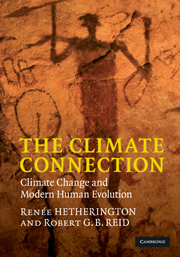Book contents
- Frontmatter
- Contents
- Foreword
- Preface
- Acknowledgements
- 1 Introduction
- Part I Early human history
- 2 From ape to human: the emergence of hominins
- 3 Human behavioural evolution
- 4 The migrations and diaspora of Homo
- Part II Climate during the last glacial cycle
- Part III The interaction between climate and humans
- Appendices: The biological background to the story of evolution
- References
- Index
- Plate section
4 - The migrations and diaspora of Homo
Published online by Cambridge University Press: 05 August 2012
- Frontmatter
- Contents
- Foreword
- Preface
- Acknowledgements
- 1 Introduction
- Part I Early human history
- 2 From ape to human: the emergence of hominins
- 3 Human behavioural evolution
- 4 The migrations and diaspora of Homo
- Part II Climate during the last glacial cycle
- Part III The interaction between climate and humans
- Appendices: The biological background to the story of evolution
- References
- Index
- Plate section
Summary
Introduction
As we discussed in the previous chapter, human physiological and behavioural adaptability provides for immediate responses to rapid climate change. During the history of hominins one typical behavioural response to changing climate has been dispersal or migration. Hominins first dispersed out of Africa nearly 2 million years ago, or earlier (e.g., Dennell and Roebroeks, 2005), but it was during the highly variable climatic period of the last glacial cycle (LGC), 135,000 to 11,650 years ago, that a new species of hominin – Homo sapiens – embarked on a series of rapid and extensive migrations that resulted in their populating both the Old and the New World.
During the LGC, flora, fauna and the geographic territories they inhabited expanded and contracted in response to climate change. Hominin populations also shifted their territories, at times following the migrations of large mammalian fauna. Movement within the same ecological niche did not require the same large behavioural adjustments that movement beyond would require. A true dispersal event, one in which hominins expanded beyond their known territory, necessitated an adjustment to new habitats and their associated subsistence resources and may have required the invention and adoption of new technologies. Therefore, if we want to understand whether hominin movements were associated with habitat expansions or were true dispersal events, we need to understand changing climate and its impact on human habitats through our history.
- Type
- Chapter
- Information
- The Climate ConnectionClimate Change and Modern Human Evolution, pp. 79 - 138Publisher: Cambridge University PressPrint publication year: 2010



